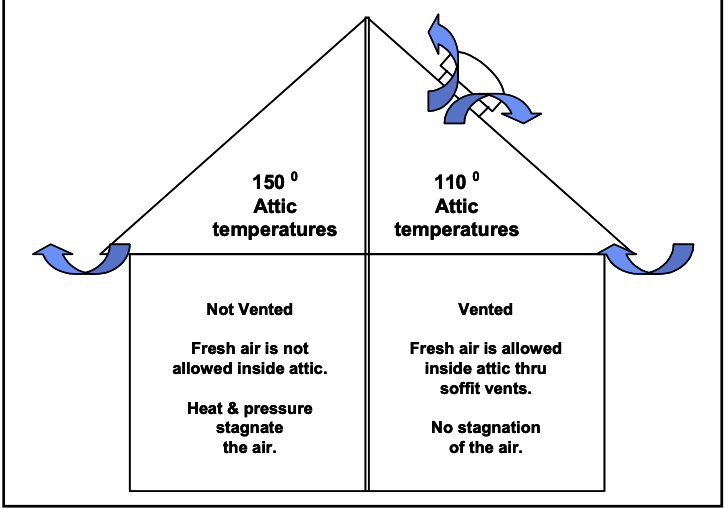

One of the most frequent and least recognized problems homeowners face is inadequate attic ventilation.
Poor attic ventilation can lead to excessive heat and attic temperatures in the summer, which will cause the pilot to
go out on standing pilot water heaters. The only resolution is to increase attic venting.
The principal source of summertime attic heat is direct sunlight on the roof of the home. This is radiated
heat, and even on a cloudy day, there is an appreciable amount transmitted to a roof. This solar heat on the roof is
transmitted through the roof material and, in turn, is radiated to the attic. Gradually, the temperature increases until
the entire attic—the roof, floor, insulation, and air, and the water heater—are extremely hot. In an unventilated attic,
the roof may reach a temperature in excess of 160 degrees Fahrenheit (F), and the attic floor 150 degrees F or more
when the outside temperature is in the 90s.
Why Does This Happen?
Essentially the pilot outage of the water heater is caused by the heat and lack of ventilation. The reasons are a
combination of the laws of physics. The one most important for this example is Charles’ Law.
Charles’ Law – If the pressure on a gas (air) is constant, the volume is directly proportional to its temperature. That
means as the temperature increases, such as in an attic in the summer time, the volume (amount of space it occupies)
of the air in the attic increases.
As the sun heats the atmosphere
inside the attic, the air molecules begin to
move faster and the air pressure inside the
attic increases. If you partially inflate a
balloon and place it in the hot sun for a
few hours, the balloon will get larger. This
is Charles’ Law in action. As the air inside
the balloon is heated, the air pressure
increases to make the balloon expand. If
you totally inflate a balloon and place it in
the freezer, the balloon will appear to
deflate. This is the same law in opposite
action.
Have you ever noticed how hard
it is to breath in a hot attic? The heat inside the attic also causes the air molecules to move faster. That means the
oxygen molecules required to support the pilot flame are farther apart and combustion cannot be supported. Using
natural gas, there must be an air mixture of between 4 and 14 percent to support combustion. An overheated attic
causes this percentage to drop below the minimum 4%. There is less oxygen available in a cubic foot of air in a very
hot attic. As the air heats, it attempts to move up (heat rises) and look for a place at the top of the attic to escape
outside. If there are no venting structures at the apex of the attic, such as ridge vents or attic fans, then the air traps
and stagnates.
For each 1,000 Btu of gas burned, there may be up to 30 cubic feet of air required for combustion air, draft
hood dilution air and general ventilation of the air space around the water heater. As the air space in the attic is
heated, and without a constant and adequate fresh air source, the pilot flame on the water heater will ‘suffocate’ and
eventually extinguish.
The heat in the attic builds up over a long period of hot weather; often over many days at a time. The
heavier the structural material, the thicker the insulation and the amount of stored items present, the greater the
amount of heat may be stored. Eventually, the atmosphere in the attic will get so hot, and the air pressure so great,
that the air will migrate OUT of the soffit vents located at the floor level of the attic.
Adequate ventilation can substantially reduce attic temperatures. On warm, windless summer days,
construction experts recommend there be a maximum 10 to 15 degrees difference between the air in the attic and a
shady spot outside the home. To accomplish this you need to increase the airflow inside the attic. Ridge and soffit
vents allow natural airflow; fans activated by temperature cut-off switches can also help move the air. Cooler air
will enter the attic at the soffit vents under the exterior roof overhangs. As this air warms inside the attic, natural
convection pushes it to the ridges at the top of the roof (heat rises) where it vents to the outside. During hot weather,
a thermostat automatically operates a roof-mounted fan as needed to increase the air circulation. To determine your
attic ventilation needs with either natural or powered systems, Rheem suggests you contact a licensed construction
or roofing professional.
Extreme weather conditions may cause the pilot to go out, even though the home is built to code and has
sufficient attic ventilation. When outside temperature exceed 100° F, our experience shows that even the best
ventilated attics may demonstrate temperatures above 150° and the pilot may extinguish.
Poor attic ventilation can lead to excessive heat and attic temperatures in the summer, which will cause the pilot to
go out on standing pilot water heaters. The only resolution is to increase attic venting.
The principal source of summertime attic heat is direct sunlight on the roof of the home. This is radiated
heat, and even on a cloudy day, there is an appreciable amount transmitted to a roof. This solar heat on the roof is
transmitted through the roof material and, in turn, is radiated to the attic. Gradually, the temperature increases until
the entire attic—the roof, floor, insulation, and air, and the water heater—are extremely hot. In an unventilated attic,
the roof may reach a temperature in excess of 160 degrees Fahrenheit (F), and the attic floor 150 degrees F or more
when the outside temperature is in the 90s.
Why Does This Happen?
Essentially the pilot outage of the water heater is caused by the heat and lack of ventilation. The reasons are a
combination of the laws of physics. The one most important for this example is Charles’ Law.
Charles’ Law – If the pressure on a gas (air) is constant, the volume is directly proportional to its temperature. That
means as the temperature increases, such as in an attic in the summer time, the volume (amount of space it occupies)
of the air in the attic increases.
As the sun heats the atmosphere
inside the attic, the air molecules begin to
move faster and the air pressure inside the
attic increases. If you partially inflate a
balloon and place it in the hot sun for a
few hours, the balloon will get larger. This
is Charles’ Law in action. As the air inside
the balloon is heated, the air pressure
increases to make the balloon expand. If
you totally inflate a balloon and place it in
the freezer, the balloon will appear to
deflate. This is the same law in opposite
action.
Have you ever noticed how hard
it is to breath in a hot attic? The heat inside the attic also causes the air molecules to move faster. That means the
oxygen molecules required to support the pilot flame are farther apart and combustion cannot be supported. Using
natural gas, there must be an air mixture of between 4 and 14 percent to support combustion. An overheated attic
causes this percentage to drop below the minimum 4%. There is less oxygen available in a cubic foot of air in a very
hot attic. As the air heats, it attempts to move up (heat rises) and look for a place at the top of the attic to escape
outside. If there are no venting structures at the apex of the attic, such as ridge vents or attic fans, then the air traps
and stagnates.
For each 1,000 Btu of gas burned, there may be up to 30 cubic feet of air required for combustion air, draft
hood dilution air and general ventilation of the air space around the water heater. As the air space in the attic is
heated, and without a constant and adequate fresh air source, the pilot flame on the water heater will ‘suffocate’ and
eventually extinguish.
The heat in the attic builds up over a long period of hot weather; often over many days at a time. The
heavier the structural material, the thicker the insulation and the amount of stored items present, the greater the
amount of heat may be stored. Eventually, the atmosphere in the attic will get so hot, and the air pressure so great,
that the air will migrate OUT of the soffit vents located at the floor level of the attic.
Adequate ventilation can substantially reduce attic temperatures. On warm, windless summer days,
construction experts recommend there be a maximum 10 to 15 degrees difference between the air in the attic and a
shady spot outside the home. To accomplish this you need to increase the airflow inside the attic. Ridge and soffit
vents allow natural airflow; fans activated by temperature cut-off switches can also help move the air. Cooler air
will enter the attic at the soffit vents under the exterior roof overhangs. As this air warms inside the attic, natural
convection pushes it to the ridges at the top of the roof (heat rises) where it vents to the outside. During hot weather,
a thermostat automatically operates a roof-mounted fan as needed to increase the air circulation. To determine your
attic ventilation needs with either natural or powered systems, Rheem suggests you contact a licensed construction
or roofing professional.
Extreme weather conditions may cause the pilot to go out, even though the home is built to code and has
sufficient attic ventilation. When outside temperature exceed 100° F, our experience shows that even the best
ventilated attics may demonstrate temperatures above 150° and the pilot may extinguish.

